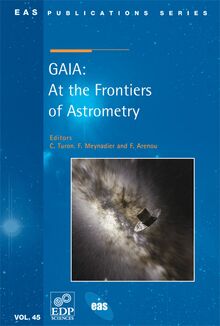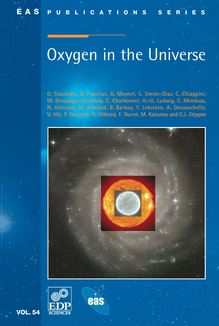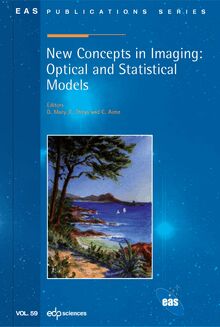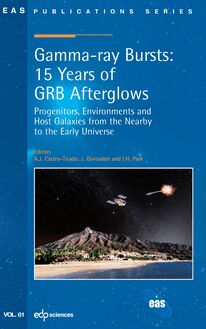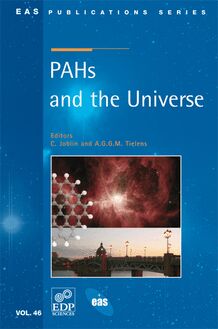-
 Univers
Univers
-
 Ebooks
Ebooks
-
 Livres audio
Livres audio
-
 Presse
Presse
-
 Podcasts
Podcasts
-
 BD
BD
-
 Documents
Documents
-
- Cours
- Révisions
- Ressources pédagogiques
- Sciences de l’éducation
- Manuels scolaires
- Langues
- Travaux de classe
- Annales de BEP
- Etudes supérieures
- Maternelle et primaire
- Fiches de lecture
- Orientation scolaire
- Méthodologie
- Corrigés de devoir
- Annales d’examens et concours
- Annales du bac
- Annales du brevet
- Rapports de stage
La lecture à portée de main
Découvre YouScribe en t'inscrivant gratuitement
Je m'inscrisDécouvre YouScribe en t'inscrivant gratuitement
Je m'inscrisEn savoir plus
En savoir plus

Description
This book, written by a group of specialists in the different areas involved, summarises what we understand of the production and distribution of oxygen, the most abundant metal in the Universe. After presenting the methods of oxygen abundance determination in various media, it traces a panorama of oxygen in the Universe, describes the mechanisms and sites of oxygen production and finally discusses the chemical evolution of oxygen in different galactic and extra galactic contexts. An appendix thoroughly discusses the oxygen atomic data.
Sujets
Informations
| Publié par | EDP Sciences |
| Date de parution | 01 mai 2012 |
| Nombre de lectures | 0 |
| EAN13 | 9782759824854 |
| Langue | English |
| Poids de l'ouvrage | 19 Mo |
Informations légales : prix de location à la page 0,0005€. Cette information est donnée uniquement à titre indicatif conformément à la législation en vigueur.
Extrait
EAS Publications Series, Volume 54, 2012
Oxygen in the Universe
G. Stasinska,´
N. Prantzos, G. Meynet, S. Sim´ on-D´ıaz,
C. Chiappini, M. Dessauges-Zavadsky, C. Charbonnel,
H.-G. Ludwig, C. Mendoza, N. Grevesse, M. Arnould,
B. Barbuy, Y. Lebreton, A. Decourchelle, V. Hill, P. Ferrando,
G. H´ebrard, F. Durret, M. Katsuma and C.J. Zeippen
November 2011
17 avenue du Hoggar, PA de Courtabœuf, B.P. 112, 91944 Les Ulis cedex A, France
First pages of all issues in the series and full-text articles
in PDF format are available to registered users at:
http://www.eas-journal.orgCover Figure
Planetary nebula Abell 39
http://www.noao.edu/image_gallery/html/im0636.html
Credit WIYN/NOAO/NSF
The spiral galaxy UGC 12158
Credit ESA/Hubble & NASA
http://www.spacetelescope.org/images/potw1035a/
Sun
http://sdo.gsfc.nasa.gov/data/rules.php
Courtesy of NASA/SDO and the AIA, EVE, and HMI science teams.
Indexed in: ADS, Current Contents Proceedings – Engineering & Physical Sciences,
ISTPr /ISI Proceedings, ISTP/ISI CDROM Proceedings.
ISBN 978-2-7598-0710-9 EDP Sciences Les Ulis
ISSN 1633-4760
e-ISSN 1638-1963
This work is subject to copyright. All rights are reserved, whether the whole or part of the
material is concerned, specifically the rights of translation, reprinting, re-use of illustrations,
recitation, broad-casting, reproduction on microfilms or in other ways, and storage in data banks.
Duplication of this publication or parts thereof is only permitted under the provisions of the
French Copyright law of March 11, 1957. Violations fall under the prosecution act of the French
Copyright Law.
c EAS, EDP Sciences 2012
Printed in UKAuthors Affiliations
M. Arnould, Institut d’Astronomie et d’Astrophysique, Universit´eLibre
de Bruxelles, CP. 226, Campus Plaine, Boulevard du Triomphe, 1050 Brussels,
Belgium
B. Barbuy, Universidade de Sa˜o Paulo - IAG, Rua do Matao˜ 1226, 05508-900 Sao˜
Paulo, Brazil
C. Charbonnel, Geneva Observatory, University of Geneva, Chemin des
Maillettes 51, 1290 Versoix, Switzerland & IRAP, UMR 5572 CNRS, and
Universit´e de Toulouse, 14 Av. E. Belin, 31400 Toulouse, France
C. Chiappini, Leibniz-Institut fur¨ Astrophysik Potsdam (AIP), An der Sternwarte
16, 14482 Potsdam, Germany
A. Decourchelle, Service d’Astrophysique SAp/IRFU/DSM and Laboratoire AIM,
CEA-IRFU/CNRS/Universit´e Paris Diderot, CEA Saclay, L’Orme des
Merisiers, Bˆ at. 709, 91191 Gif-sur-Yvette Cedex, France
M. Dessauges-Zavadsky, Geneva Observatory, University of Geneva, Chemin des
Maillettes 51, 1290 Versoix, Switzerland
F. Durret, UPMC-CNRS, UMR 7095, Institut d’Astrophysique de Paris, 75014
Paris, France
P. Ferrando, CEA/DSM/IRFU/ Service d’Astrophysique & UMR APC, CEA
Saclay, 91191 Gif-sur-Yvette, France
N. Grevesse, Centre Spatial de Li`ege, Universit´ede Li`ege, Avenue du Pr´e Aily,
4031 Angleur-Li`ege, Belgium and Institut d’Astrophysique et de G´eophysique,
Universit´ede Li`ege, All´ee du 6 Aouˆt, 17, B5C, 4000 Li`ege, Belgium
G. H´ebrard, UPMC-CNRS, UMR 7095, Institut d’Astrophysique de Paris, 75014
Paris, France
V. Hill, Universit´e de Nice Sophia Antipolis, CNRS, Observatoire de la Cotˆ e
d’Azur, Bd. de l’Observatoire, BP. 4229, 06304 Nice Cedex 4, France
M. Katsuma, Institut d’Astronomie et d’Astrophysique, Universit´eLibre
de Bruxelles, CP. 226, Campus Plaine, Boulevard du Triomphe, 1050 Brussels,
Belgium
Y. Lebreton, GEPI & UMR CNRS 8111, Observatoire de Paris, 92195 Meudon
Cedex, France and Universit´e de Rennes 1, IPR, Bˆat. 11B, Case 1107, Campus
de Beaulieu, 35042 Rennes Cedex, France
H.-G. Ludwig, ZAH, Landessternwarte, Kon¨ igstuhl 12, 69117 Heidelberg,
Germany
C. Mendoza, Centro de F´ısica, Instituto Venezolano de Investigaciones Cient´ıficas
(IVIC), Apdo. Postal 20632, Caracas 1020A, Venezuela, and Centro Nacional deIV
C´ alculo Cient´ıfico Universidad de Los Andes (CeCalCULA), Corporaci´ on Parque
Tecnol´ ogico de M´erida, M´erida 5101, Venezuela
G. Meynet, Geneva Observatory, University of Geneva, Chemin des Maillettes 51,
1290 Versoix, Switzerland
N. Prantzos, UPMC-CNRS, UMR 7095, Institut d’Astrophysique de Paris, 75014
Paris, France
S. Sim´ on-D´ıaz, Instituto de Astrof´ısica de Canarias, 38200 La Laguna, Tenerife,
Spain and Departamento de Astrof´ısica, Universidad de La Laguna, 38205 La
Laguna, Tenerife, Spain
G. Stasins´ ka, LUTH, Observatoire de Paris, CNRS, Universit´e Paris Diderot, 5,
Place Jules Janssen, 92190 Meudon, France
C.J. Zeippen, LERMA, Observatoire de Paris, ENS, UPMC, UCP, CNRS, 5, place
Jules Janssen, 92190 Meudon, FranceList of abbreviations
AGB asymptotic giant branch
CEL collisional emission line
DLA damped lyman alpha system
GRB gamma-ray burst
IGM intergalactic medium
IMF initial mass function
ISM interstellar medium
LMC Large Magellanic Cloud
LTE local thermodynamic equilibrium
MS main sequence
MW Milky Way
NLTE out of local thermodynamic equilibrium
ORL optical recombination line
QSO quasar
RGB red giant branch
SFH star formation history
SFR star formation rate
SMC Small Magellanic Cloud
SN supernova
SNIa Type Ia supernova
SNII Type II supernova
SNR supernova remnant
SoS solar system
WR Wolf-Rayet
ZAMS zero-age main sequence
NOTATIONS
All the wavelenghts are in Angstroms, unless specified otherwiseContents
Foreword 1
1 How to Derive Oxygen Abundances 3
1.1 Oxygen abundance scales and notations . . . . . . . . . . . . . . . 3
1.2 Spectroscopicmethods . .. .. ... .. .. ... .. .. ... .. 5
1.2.1 Basics of line formation . . . . . . . . . . . . . . . . . . . . 5
1.2.1.1 LTEandNLTE ... .. .. ... .. .. ... .. 7
1.2.1.2 Broadening of spectral lines in gaseous media . . . 9
1.2.1.3 Emission lines . . . . . . . . . . . . . . . . . . . . 12
1.2.2 Methods using absorption lines . . . . . . . . . . . . . . . . 14
1.2.2.1 Stellaratmospheres . .. .. ... .. .. ... .. 14
Basics of model atmosphere construction. . . . . . 14
Stellar model atmosphere codes. . . . . . . . . . . 17
Oxygen abundance indicators for different stellar
types. .. .. .. ... .. .. ... .. .. ... .. 18
Coolstars. .. .. . .. .. .. . .. .. .. . .. . 19
Hydrodynamical model atmospheres of cool stars. 19
Derivation of stellar parameters in cool stars. . . . 22
Effective Temperature . .. ... .. 23
Gravity .. .. ... .. .. ... .. 23
Microturbulence... .. .. ... .. 23
Oxygen abundance indicators in cool stars. . . . . 23
Abundance uncertainties in cool stars. . . . . . . . 26
Hotstars.. . . . . .. .. .. ... .. .. ... .. 26
Model atmospheres for hot stars. . . . . . . . . . . 28
Derivation of stellar parameters in hot stars. . . . 29
Abundance analysis in hot stars. . . . . . . . . . . 30
The curve of growth method ... .. 30
The spectral synthesis method .. .. 31
Abundance uncertainties in hot stars. . . . . . . . 32
1.2.2.2 Interstellarmedium . .. .. ... .. .. ... .. 34
1.2.3 Methodsusingemissionlines . . . .. ... .. .. ... .. 42
1.2.3.1 Photoionised nebulae . . . . . . . . . . . . . . . . 42
1.2.3.2 Collisionally ionised media . . . . . . . . . . . . . 59viii Oxygen in the Universe
1.3 In situMethods. .. .. ... .. ... .. .. ... .. .. ... .. 60
1.3.1 Meteorites.. .. ... .. ... .. .. ... .. .. ... .. 60
1.3.2 CosmicRays .. ... .. ... .. .. ... .. .. ... .. 61
1.3.2.1 Cosmic-ray basics . . . . . . . . . . . . . . . . . . 61
1.3.2.2 Measurementtechniques .. ... .. .. ... .. 62
2 A Panorama of Oxygen in the Universe 65
2.1 TheSunandthesolarsystem . . . .. .. .. ... .. .. ... .. 65
2.1.1 Constraints from solar interior modelling
andhelioseismology . .. ... .. .. ... .. .. ... .. 65
2.1.1.1 Constructing a solar evolution sequence and the
presentsolarinteriormodel . ... .. .. ... .. 65
2.1.1.2 Constraining the solar model with the observations 66
2.1.1.3 Results and caveats of solar model calculations . . 71
2.1.1.4 Can we satisfy seismic inferences in solar models
basedonthenewmixture? . ... .. .. ... .. 73
2.1.2 Thesolaratmosphere . .. . .. .. .. . .. .. .. . .. . 75
2.1.2.1 The photosphere . . . . . . . . . . . . . . . . . . . 75
2.1.2.2 Thecorona . .. ... .. .. ... .. .. ... .. 83
2.1.2.3 Some implications of the new low solar abundance
ofOandcomments . .. .. ... .. .. ... .. 84
2.1.2.4 Conclusions. .. ... .. .. ... .. .. ... .. 85
2.1.3 Meteorites.. .. ... .. ... .. .. ... .. .. ... .. 86
2.1.3.1 The meteoritic oxygen abundances and isotopic
compositions . .. . .. .. .. . .. .. .. . .. . 88
2.1.3.2 Bulk oxygen isotopic compositions of chondrites
andachondrites . . .. .. .. . .. .. .. . .. . 89
2.1.3.3 O isotopic anomalies in chondritic components . . 90
2.1.3.4 Oxygen anomalies in stardust grains . . . . . . . . 91
2.1.3.5 Origin of the SoS O isotopic anomalies in chondrite
components. .. ... .. .. ... .. .. ... .. 94
2.1.3.6 Origin of the stardust grains with isotopically
anomalous oxygen . . . . . . . . . . . . . . . . . . 95
2.2 TheMilkyWay . .. .. . .. .. ... .. .. ... .. .. ... .. 96
2.2.1 Solarvicinity .. ... .. ... .. .. ... .. .. ... .. 98
2.2.1.1 Cosmicrays . . . .. .. .. ... .. .. ... .. 98
2.2.1.2 Diffuseinterstellarmedium . ... .. .. ... .. 103
2.2.1.3 H iiregions. .. ... .. .. ... .. .. ... .. 107
2.2.1.4 Early B-type stars . . . . . . . . . . . . . . . . . . 108
2.2.1.5 Solar analogs . . . . . . . . . . . . . . . . . . . . . 110
2.2.1.6 Late type giants . . . . . . . . . . . . . . . . . . . 112
2.2.1.7 Planetary nebulae . . . . . . . . . . . . . . . . . . 113
2.2.1.8 Supernovaremnants . .. .. ... .. .. ... .. 115
2.2.1.9 Summary .. .. ... .. .. ... .. .. ... .. 116
2.2.2 TheMilkyWaydisk . .. ... .. .. ... .. .. ... .. 119Contents ix
2.2.2.1 Openclusters. . . .. .. .. ... .. .. ... .. 120
2.2.2.2 H iiregions. .. ... .. .. ... .. .. ... .. 120
2.2.2.3 Young stars . . . . . . . . . . . . . . . . . . . . . . 124
2.2.2.4 Cepheids . . . . . .. .. .. ... .. .. ... .. 127
2.2.2.5 Planetary nebulae . . . . . . . . . . . . . . . . . . 128
2.2.2.6 Summary of abundance gradients in the Milky
Way... .. .. ... .. .. ... .. .. ... .. 132
2.2.2.7 Thickdiskstars ... .. .. ... .. .. ... .. 133
2.2.3 The Milky Way bulge . . . . . . . . . . . . . . . . . . . . .
-
 Univers
Univers
-
 Ebooks
Ebooks
-
 Livres audio
Livres audio
-
 Presse
Presse
-
 Podcasts
Podcasts
-
 BD
BD
-
 Documents
Documents
-
Jeunesse
-
Littérature
-
Ressources professionnelles
-
Santé et bien-être
-
Savoirs
-
Education
-
Loisirs et hobbies
-
Art, musique et cinéma
-
Actualité et débat de société
-
Jeunesse
-
Littérature
-
Ressources professionnelles
-
Santé et bien-être
-
Savoirs
-
Education
-
Loisirs et hobbies
-
Art, musique et cinéma
-
Actualité et débat de société
-
Actualités
-
Lifestyle
-
Presse jeunesse
-
Presse professionnelle
-
Pratique
-
Presse sportive
-
Presse internationale
-
Culture & Médias
-
Action et Aventures
-
Science-fiction et Fantasy
-
Société
-
Jeunesse
-
Littérature
-
Ressources professionnelles
-
Santé et bien-être
-
Savoirs
-
Education
-
Loisirs et hobbies
-
Art, musique et cinéma
-
Actualité et débat de société
- Cours
- Révisions
- Ressources pédagogiques
- Sciences de l’éducation
- Manuels scolaires
- Langues
- Travaux de classe
- Annales de BEP
- Etudes supérieures
- Maternelle et primaire
- Fiches de lecture
- Orientation scolaire
- Méthodologie
- Corrigés de devoir
- Annales d’examens et concours
- Annales du bac
- Annales du brevet
- Rapports de stage
